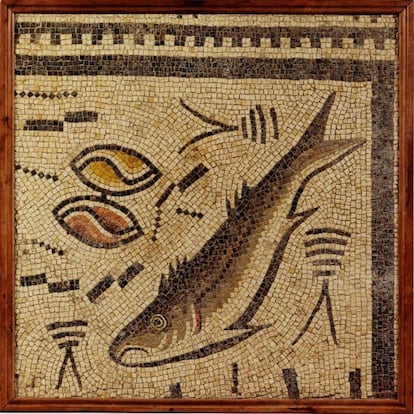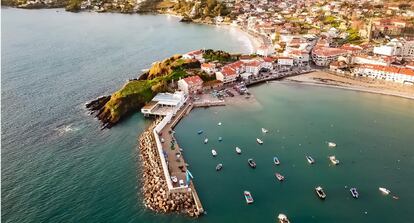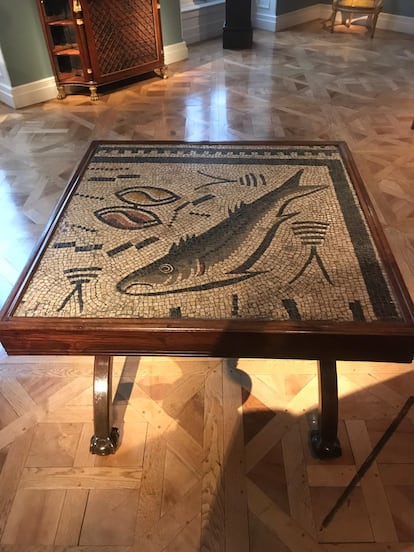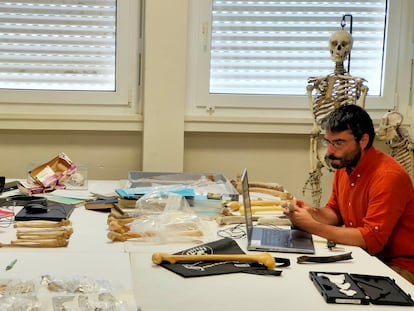A community in Spain works to recover ancient Roman mosaic that ended up in New York
After a long journey, the piece ended up at the Carlton Hobbs gallery. A crowdfunding effort raised money to buy it back, but local authorities have yet to live up to their side of the bargain

Like most baby-boomers of the 1970s growing up in Vigo, a city in Spain’s northwestern region of Galicia, Gonzalo Fernández-Turégano used to spend long hours gazing at the black-and-white photographs of a thick book with greenish covers titled Vigo en su historia (Vigo in its history). That kid, who was born in 1976 and is now a lawyer, a banking executive and an art lover based in Madrid, used to pass the time at his aunt and uncle’s house turning the pages of the 676-page volume; however, time and time again, he got stuck – or rather, captivated – between pages 49 and 53. That was where a mullet and a couple of clams depicted with tesserae tiles awaited. The animals floated on an ocean floor represented by water flies, the same symbol (superimposed lines, with a kind of mustache at one end) found in other Iberian mosaics with a marine theme. The text that accompanied the image of the Roman Mosaic of Panxón included explanations from archaeologist Fernando Acuña Castroviejo, who had researched the origins of the piece.
According to that specialist, at some point prior to 1850, a family named Puga who lived in the municipality of Nigrán, accidentally discovered this 3rd-century vestige while working on their property by the sea; the mosaic was much larger, but the Pugas only saved a piece from destruction by commissioning a Roman-style scissor table to encase it. Then they sold the piece of furniture to collector Ricardo Blanco Cicerón. More than a century later, in 2000, the piece reappeared in Castellana Subastas, an auction house in Madrid. There it was bought by a Danish bidder and by 2012 the mosaic had already crossed the Atlantic from London and was in the Carlton Hobbs gallery in New York. But back in Galicia, people had lost track of it. Until 2018, that is, when after examining online catalogs of art houses, Fernández-Turégano found before his eyes the solemn fish and the clams from his childhood book.
“I saw it by chance, it was for sale,” says the rediscoverer of this jewel. “On a trip to New York I made an appointment to see it. Carlton Hobbs had no idea about its origin, although the then curator of Roman art at the Metropolitan Museum, Carlos Picón, had identified it as a 3rd-century Lusitanian mosaic. I said that I was interested in repatriating it, and he said that if the intention was to exhibit it, he would be willing to lower the price, from $75,000 to $58,000.″
After that, a group of residents and people emotionally linked to Nigrán — a seaside resort south of Vigo — formed the Association for the Repatriation of the Roman Mosaic of Panxón. Fernández-Turégano is first vice president; his aunt, the retired doctor Pilar Pérez Saavedra, is president; and history teacher Gustavo Pascual is the second vice president. Other supporters of the drive to bring back the mosaic include sailors like Diego Torrado, cultural managers and professional surfers like Gony Zubizarreta. In October 2020, this citizen collective signed a reserve agreement with Stefanie Rinza, manager of the Carlton Hobbs gallery, and the dealer specialized in furniture of the European aristocracy of the 17th, 18th and 19th centuries. The gallery pledged not to sell the Galician mosaic to anyone for two years (that is, until next October), giving the association time to raise funds.

The group launched a crowdfunding campaign, and at the same time managed to obtain a commitment from the City Council of Nigrán, which is led by a mayor with a degree in Art History, the socialist Juan González. The council approved a contribution of €40,000; the rest would have to be collected by the association. As stated in the association’s charter, as soon as the piece arrived in Galicia it would be handed over to the Nigrán Council, which would guarantee its conservation and exhibition in a museum devoted to the evident – and still unexplored – Roman past of Panxón.
At the end of August, the group announced that the crowdfunding goal had been achieved, but lamented the absence of fresh news regarding the city’s contribution to the cause. “All that remains now is to sign the agreement by which the association would donate the piece to the City Council... We hope to make it on time so that the table does not end up decorating a ranch in Texas!” says Fernández-Turégano, sounding worried. “Our job was to light the spark and then move away to a discreet position in the background. We leave the glory of cutting the ribbon to the politicians. We assume that the mayor, who knows about art, will love to go down in history as the leader who returned the mosaic to Nigrán. Carlton Hobbs and Stefanie Rinza showed a lot of generosity, and we can’t let them down now.”

Antique pottery fished in the bay
A 19th-century manuscript cited by Acuña Castroviejo stated that the Panxón mosaic was originally much larger. The preserved fragment (a square measuring 33.5 inches on each side) is just a corner of a scene in which – according to the text – there were also some kind of forts or “castles” and some “figures”. But the mosaic was “torn down,” it said. At the site of the discovery – an idyllic, wave-beaten rocky hillside that separates two beaches and tops off the port of Panxón – nobody ever excavated to confirm what the name of that place, O Castro (or The Hillfort), insists on revealing. On the contrary: despite the discovered mosaic and the defensive moat that can be perceived where the grass now thrives, the spot’s pre-Roman and Roman past was confined by buildings, a maritime club and a cement breakwater.
A few feet from O Castro, a Roman pottery workshop, an altar dedicated to Mercury (the god of commerce), and several small amphorae that floated to the surface hooked on fishing gear emerged – also by chance. The mosaic is linked to water-related facility inside what might have been a Roman villa or a factory for the exploitation of sea resources. “Panxón did not withstand the onslaught of urban growth and its acropolis was altered by real estate development,” laments Gustavo Pascual in the report on the Roman mosaic that is published on the association’s website. “The urban pressure in the region (...) was so strong that it affected the natural spaces and many archaeological sites.”
Tu suscripción se está usando en otro dispositivo
¿Quieres añadir otro usuario a tu suscripción?
Si continúas leyendo en este dispositivo, no se podrá leer en el otro.
FlechaTu suscripción se está usando en otro dispositivo y solo puedes acceder a EL PAÍS desde un dispositivo a la vez.
Si quieres compartir tu cuenta, cambia tu suscripción a la modalidad Premium, así podrás añadir otro usuario. Cada uno accederá con su propia cuenta de email, lo que os permitirá personalizar vuestra experiencia en EL PAÍS.
¿Tienes una suscripción de empresa? Accede aquí para contratar más cuentas.
En el caso de no saber quién está usando tu cuenta, te recomendamos cambiar tu contraseña aquí.
Si decides continuar compartiendo tu cuenta, este mensaje se mostrará en tu dispositivo y en el de la otra persona que está usando tu cuenta de forma indefinida, afectando a tu experiencia de lectura. Puedes consultar aquí los términos y condiciones de la suscripción digital.
More information
Últimas noticias
Most viewed
- Sinaloa Cartel war is taking its toll on Los Chapitos
- Oona Chaplin: ‘I told James Cameron that I was living in a treehouse and starting a permaculture project with a friend’
- Reinhard Genzel, Nobel laureate in physics: ‘One-minute videos will never give you the truth’
- Why the price of coffee has skyrocketed: from Brazilian plantations to specialty coffee houses
- Silver prices are going crazy: This is what’s fueling the rally










































